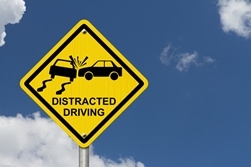It’s safe to say that many drivers feel that they can’t live without their cell phones. Phones often provide drivers with everything they need—including schedules, contact information, navigational equipment, and so much more. Therefore, it’s no wonder that many drivers have a hard time putting their phones down—even while they are driving.
Types of Distracted Driving
Phones aren’t the only cause of distraction for drivers. In fact, drivers can become distracted for a variety of reasons, including other passengers in the vehicle, operating the car stereo, and events that occur on the side of the road. When drivers become distracted, it is more than their minds that become preoccupied. Three different types of distractions can occur:
- Cognitive distraction. Also called mental distraction, cognitive distraction occurs when a driver’s mind isn’t focused on the road. This includes daydreaming, reading a text, speaking to a passenger in the vehicle, or paying attention to music that is playing in the vehicle.
- Manual distraction. This type of distraction occurs when a driver removes his hands from the wheel. This is usually done to use the phone, operate navigational or audio tools in the vehicle, grab something out of a wallet, or hand items to children or other passengers in the vehicle.
- Visual distraction. As the name implies, a visual distraction involves looking at something other than the road. Reading a text, staring at the dashboard, and looking at a map are all reasons why drivers often engage in this dangerous behavior.
The Scope of the Problem
Distracted driving is a far more common and dangerous problem than you may think. If you’ve never become distracted while driving, there’s a good chance that the person in the car next to you has. In fact, the Centers for Disease Control and Prevention state that:
- Drivers under the age of 20 are the most likely to engage in distracting behavior while driving.
- In 2013, more than two out of five students who drove in the past 30 days sent a text or email while driving.
- Students who frequently text while driving are more likely to drive with a driver who has been drinking, or drink and drive themselves.
Additionally, according to the National Highway Traffic and Safety Administration (NHTSA), over 3,331 people were killed and over 387,000 were injured in accidents due to distracted driving.
The Characteristics of Distracted Driving
Sending a quick text or checking an email may not seem like a big deal—but the actions can last longer than you may think. In fact, sending or receiving a text distracts a driver for about five seconds. If traveling at highway speeds, this means that your vehicle is essentially out of human control for about 300 feet.
Distracted driving often causes drivers to swerve, drive through stop signs and traffic lights, cause rear-end accidents, and even strike bicyclists and pedestrians.
When a Distracted Driver Hurts You and Your Family
When you are injured by a distracted driver, it’s not just you who feels the impact. Your family also suffers. Not only can your family experience the stress that is involved with the aftermath of the crash, they can also feel the effects that the medical bills and time lost from work can create.
The insurance company likely won’t give you all of the help you need to cover the expenses related to your accident. However, the legal team at Kennedy Law Firm, LLP will do all they can to help you receive the compensation you deserve. Call us today to schedule an appointment with a legal professional to discuss your situation and start learning more about your rights.


 01 July 2020
01 July 2020 
